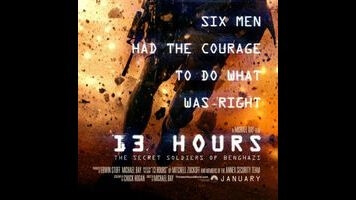“Downtime’s the worst; the adrenaline leaves and my mind just starts to wander,” says CIA security contractor Jack Silva (John Krasinski) about two-thirds of the way through 13 Hours: The Secret Soldiers Of Benghazi, inadvertently summing up what’s wrong with Michael Bay’s latest, a cool 90-minute action flick padded out into a lumbering ooh-rah male weepie. Overlong and at times ponderous, and prone to a slobs vs. snobs mentality that pits prissy CIA agents against the men’s men on their payroll, 13 Hours is also, in stretches, about as pure an action movie as Bay is likely to make. Its lengthy siege and chase set pieces combine Bay’s usual pomp (e.g., the arc of a mortar shell, followed from loading to impact) with wild, smeared, very digital camerawork of the kind that cinematographer Dion Beebe previously pulled off for Michael Mann on Collateral and Miami Vice. Packed with misfiring grenade launchers, blue lens flares, and Mercedes armored cars, 13 Hours makes the best case for Bay as a toy-box aesthete with an abstract sense of motion and color—and the best case against him as an incoherent jingoism fetishist.
Bay is a hyperactive stylist whose idea of a personal project involves imitating other, more thoughtful films about machismo. Pain & Gain, about the exploits of a real-life gang of extortionist bodybuilders, aped Casino-era Scorsese (multiple narrators, Rolling Stones, coked-up violence, etc.), and 13 Hours at times feels like Bay’s take on Mann, with plenty of jargon and clipped tough-guy emoting, and a whole cast of professionals who don’t fit in with the straight world. The director hasn’t put this much stock in the audience giving a damn about characters since Pearl Harbor, but while 13 Hours is a somewhat better brothers-in-arms movie than the earlier film was a romance, that’s not saying much. Posturing so hard that he probably threw out his back during production, Bay waves scorched American flags and takes swipes at the elitism of Harvard and Yale. (Bay himself went to Wesleyan, so maybe it’s personal.) On an ideological level, the movie is an ode to doing it for the money; in Bay’s brand of filmmaking, there’s nothing more American.
Adapted by novelist Chuck Hogan from the same-titled book by Mitchell Zuckoff, 13 Hours depicts the 2012 attack on a diplomatic compound in Libya and a nearby secret CIA base mostly from the point of the view of a six-man team of contractors who worked at the latter. They are all family men, former Navy SEALs and Army Rangers drawn back into conflict zones because they’re broke. At home, Silva is a realtor, “Tonto” (Pablo Schreiber) is an insurance claims adjuster, “Rone” (James Badge Dale) is a nurse, and so on and so forth. In Benghazi, though, they’re ripped and bearded bodyguards who show each other pictures of their kids and then kick ass. 13 Hours is slow to get going and interminable in its final stretch, and its politics are bogus at best; perhaps the point is to put audiences in the mindset of the eye-rolling adrenaline-junkie, secretly hoping that another Toyota Hilux will round the corner, so that one of the contractors can say “Are we expecting friendlies?” into his walkie, and all hell can break loose. (Note: This exchange happens enough times in 13 Hours to make for a drinking game.)
But does anyone go to a Michael Bay movie for the talk? Because whenever the bloviating stops and the gunfire starts, 13 Hours cuts loose with some of the most adventurous filmmaking of Bay’s career. Shooting entirely in digital formats for the first time, Bay plays with the out-there end of aesthetics, mixing 360-degree shutter angles (what most folks think of as the “video look”) with more conventionally filmic footage and disorienting close-ups with floating aerial vistas shot by camera drones. Smoke, sweat, and bulletproof glass swirl in a tense nighttime car chase that borders on visual music, composed for Bay’s preferred ensemble of explosions and solo luxury motor vehicle. Rocket-propelled grenades bounce off pavement like fireworks and cars are ripped apart into twisted metal debris, suggesting an urban firefight re-imagined as elaborate kinetic sculpture. But then comes the downtime, bringing with it a parade of cartoonish stuffed shirts and pretentious CIA agents, lots of forced misty eye, and a phony take on American can-do.


 Keep scrolling for more great stories from The A.V. Club.
Keep scrolling for more great stories from The A.V. Club.